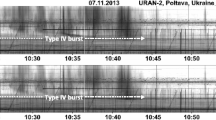Abstract
The results of a study of the coronal mass ejection (CME) of April 27, 2003, which was intrinsically associated with the active region NOAA 10338, are reported. Particular attention is paid to the initial stage of the event, which was accompanied by X-ray bursts of class C9.3 and C6.7, with the aim of determining the origin of CMEs. The energy source of the ejection was in the active region NOAA 10338. This region had a complicated and dynamic magnetic-field topology, and produced a series of CME-type events. The basis for the study was observations at wavelengths of 1.92–17 cm with high spatial resolution, 17″–20″, obtained on the Siberian Solar Radio Telescope (SSRT) and RATAN-600, together with simultaneous data from the Nobeyama Radio Heliograph (NoRH, wavelength 1.76 cm) and 195 Å ultraviolet data from the TRACE spacecraft. The development of the event was followed over three hours, first through observations against the disk at heights of 10,000–100,000 km from the photosphere, then in the post-limb stage to distances of the order of 106 km from the solar center, i.e., in the zone inaccessible to the LASCO coronographs. According to the radio observations, ∼10 min before the beginning of the event, the radio structure of the active region NOAA 10338 had an S-shaped (sigmoid) configuration. A rising, gradually expanding dark loop originated at the points where this structure was observed; according to the TRACE data, this loop initiated the event. Subsequently, the structure of the radio image drastically changed, suggesting that coronal plasma was heated and cooled at different sites of the emission region (or was shielded by the cooler material of the ejection). Profiles of the burst that accompanied the ejection are presented for four points in the region. The post-limb part of the event first had a compact (∼50″) structure receding from the Sun and visible to distances ∼106 km. An asymmetric loop was then formed, with its material falling back onto the Sun at the end of the event. The brightness temperature of the loop was ∼15 × 103 K, and its emission was weakly polarized (P ≈16%). The mean speed of the material was 160 km/s. It is concluded that the observations of the event of April 27, 2003 are most consistent with the model of Amari et al., in which the formation of an eruptive twisted magnetic rope, taken to be responsible for CME-type events, is explained by the emergence of new magnetic flux within an old field of opposite polarity.
Similar content being viewed by others
References
Y. Hanaoka and T. Shinkawa, Astrophys. J. 510, 466 (1999).
A. M. Uralov, S. V. Lesovoi, V. G. Zandanov, et al., Sol. Phys. 208, 69 (2002).
P. Subramanian and K. P. Dere, Astrophys. J. 561, 372 (2001).
R. A. Harrison, Astron. Astrophys. 304, 585 (1995).
M. Dryer, Sol. Phys. 169, 421 (1996).
H. Kurokawa, T. Wang, and T. Ishii, Astrophys. J. 572, 598 (2002).
N. Gopalswamy and M. R. Kundu, Astrophys. J. 390, L37 (1992).
B. P. Filippov, Eruptivnye protsessy na Solntse (Eruptive Processes on the Sun) (Fizmatlit, Moscow, 2007) [in Russian].
D. M. Rust and A. Kumar, Astrophys. J. 464, L199 (1996).
R. C. Canfield, H. S. Hudson, and D. E. McKenzie, Geophys. Res. Lett. 26, 627 (1999).
R. T. Stewart, M. K. McCabe, et al., Sol. Phys. 36, 203 (1974).
J. Klimchuk, in Proceedings of the Chapman Conference on Space Weather, Ed. by P. Song, G. Siscoe, and H. Singer (AGU, Washington, 2001), AGU Monograph Ser., Vol. 125, p. 143.
R. C. Canfield, H. S. Hudson, and A. A. Pevtsov, IEEE Trans. Plasma Sci. 28, 1786 (2000).
S. E. Gibson, Y. Fan, T. Török, and B. Kliem, Space Sci. Rev. 124, 131 (2006).
A. A. Pevtsov and R. C. Canfield, J. Geophys. Res. A 106, 25191 (2001).
T. Amari, J. F. Luciani, Z. Mikic, et al., Astrophys. J. 529, L49 (2000).
T. Amari, J. F. Luciani, J. J. Aly, et al., Astrophys. J. 585, 1073 (2003).
T. Amari, J. F. Luciani, J. J. Aly, et al., Astrophys. J. 595, 1231 (2003).
Author information
Authors and Affiliations
Additional information
Original Russian Text © N.N. Kardapolova, T.P. Borisevich, N.G. Peterova, S.V. Lesovoĭ, 2008, published in Astronomicheskiĭ Zhurnal, 2008, Vol. 85, No. 5, pp. 460–470.
Rights and permissions
About this article
Cite this article
Kardapolova, N.N., Borisevich, T.P., Peterova, N.G. et al. Coronal mass ejection of April 27, 2003, and evolution of the active region NOAA 10338 in the radio. Astron. Rep. 52, 409–418 (2008). https://doi.org/10.1134/S1063772908050077
Received:
Accepted:
Published:
Issue Date:
DOI: https://doi.org/10.1134/S1063772908050077




